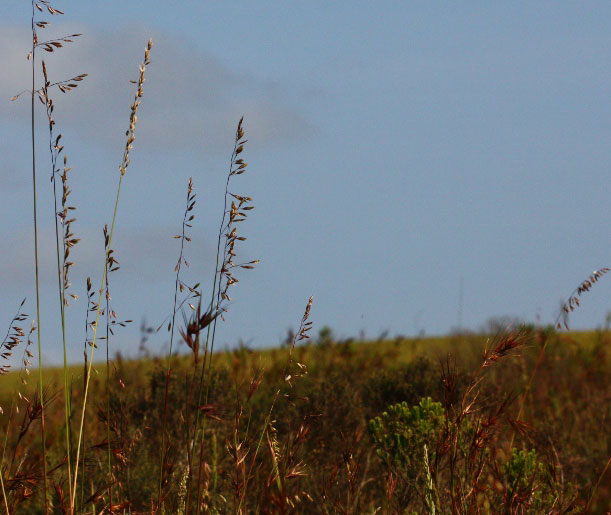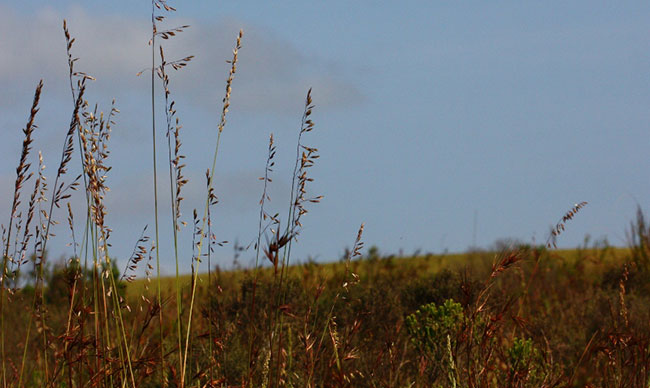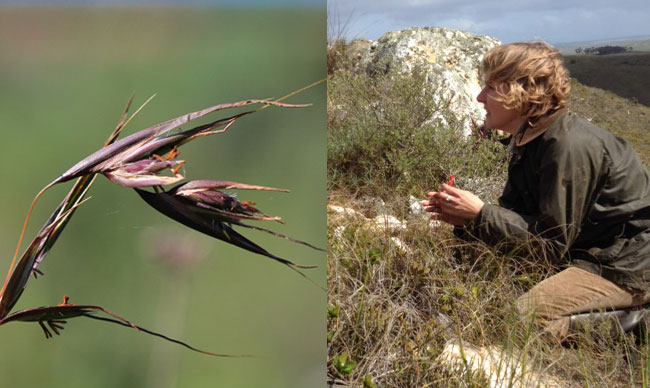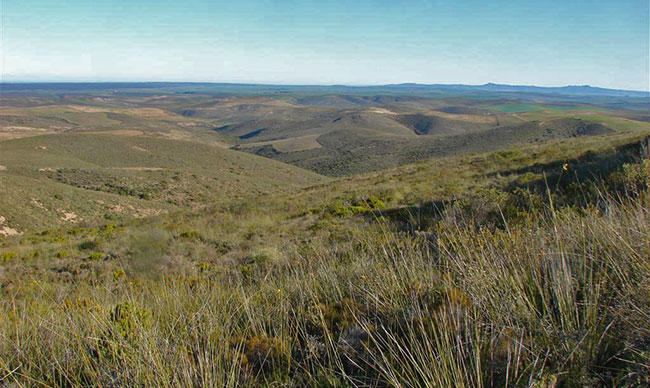The Renosterveld vegetation of South Africa’s Overberg is one of the most threatened habitats on earth. Once distributed across the rolling lowland areas of the Overberg region, these swathes of Renosterveld were home to large herds of game roaming across the landscape. Just 5% of the former extent of Overberg Renosterveld survives today after the rest was ploughed for agriculture due to the fertile soils typical of this ecosystem. The Renosterveld that remains today is mostly in relatively small patches that have survived in areas that are too steep or rocky to plough.
With Overberg Renosterveld becoming so fragmented and so little surviving today, all including even the smallest patches are important for conservation. This means that there needs to be a strong focus on effective management and knowledge of baselines for conserving Renosterveld in the Overberg. This poses important questions around what we are managing towards for the vegetation type and what constitutes ‘healthy’ Renosterveld. There has been considerable debate over many years around this subject, particularly around the proportion of shrubs and grasses in Overberg Renosterveld and how this may have changed over time.
It has been suggested by several authors that Overberg Renosterveld was historically more grassy than it is today. This is backed up by multiple accounts from the historical literature:
In 1772 Thunberg wrote about the Buffeljagsrivier area east of Swellendam: “The plains now began to abound more in grass, and looked something like meadows… In the same proportion the herds of cattle became larger and occurred more frequently”. (Skead, 2009: pp. 116).
In 1803 D.G. Van Reenen wrote in reference to the Swellendam area: “Suitable pasture for sheep is not found there, for the veld consists of sour grassland on which good grazing for sheep is scanty”. (Skead, 2009: pp. 122).
In contrast, in 1811 W.J. Burchell wrote in reference to the area between Caledon and Genadendal: “The face of the country was open and its surface varied with smooth hills covered almost exclusively with a neat pale bushy shrub of the height of 3 or 4 feet called rhinosterbosch (rhinoceros bush [Elytropappus rhinocerotis]) and said to have formerly been the food of the huge rhinoceros till those animals fled before the colonists as they gradually advanced over the country where the shrub grows”. (Skead, 2009: pp. 125).
It has been suggested that Overberg Renosterveld was historically more grassy than it is today, with an increase in shrub cover and particularly in cover of renosterbos (Elytropappus rhinocerotis) thought to be as a result of overgrazing. Authors Newton and Knight (2004) even went as far as suggesting that Renosterveld was historically a grassland until 200 years ago when the loss of indigenous grazing mammals and increase in domestic livestock grazing led to a proliferation of a more shrubby component to the vegetation. The answers to this question may never be known conclusively, but several authors have undertaken further research using palaeoecological proxies to try and find answers as to whether Renosterveld was more grassy in the past, or always a mosaic of grasses and shrubs.
For her PhD research, ORCT Director Dr. Odette Curtis-Scott took a closer look at this through the use of stable carbon isotope analysis to find out if Overberg Renosterveld was in fact a grassland in the past. Results from the study revealed that a mix of grasses and shrubs were more than likely always present, as is the case in Overberg Renosterveld today. However, these vegetation communities have always been highly heterogenous, and more research is needed to better understand what the main drivers of variation are.
Research by Forbes et al. (2018) used a variety of different palaeoecological proxies to examine changes over time in West Coast Renosterveld vegetation at Elandsberg Private Nature Reserve. Results found an increase from the late 1800s onwards of Asteraceae pollen (likely Elytropappus rhinocerotis) as well as an increased presence of macrocharcoal and coprophilous fungal spores, likely indicating an increase in grazing intensity in association with increased presence of renosterbos.
These windows into the possible history of Overberg Renosterveld from both the Overberg itself and other lowland Renosterveld vegetation are highly valuable. However, it is likely that we will never know for sure the full extent of the changes that have taken place as a result of human intervention. It is important that we recognise that the Renosterveld in our custodianship today is an altered system, and needs to be managed as such. The most important things we can do are to manage for resilience and biodiversity, adopting a strategy of adaptive management informed by applied conservation-focused research. More research into applied management practices is needed so that we can best conserve what Overberg Renosterveld remains in perpetuity for the future.
Further Reading
Curtis, O.E. (2013) Management of Critically Endangered renosterveld fragments in the Overberg, South Africa, Unpublished PhD Thesis, University of Cape Town, South Africa.
Curtis, O.E. Bond, W. (2013) ‘What is renosterveld? Grassy shrubland or shrubby grassland? Have recent analyses of soil carbon isotopes provided an answer?’, Veld and Flora, December 2013 Issue, pp. 180-183.
Forbes, C.J. Gillson, L. Hoffman, M.T. (2018) ‘Shifting baselines in a changing world: Identifying management targets in endangered heathlands of the Cape Floristic Region, South Africa’, Anthropocene (Volume 22): pp. 81-93.
Newton, I.P. Knight, R. (2004) ‘The matrix: The evolutionary development of coastal renosterveld’, Veld and Flora, December 2004 Issue, pp. 162-164.




